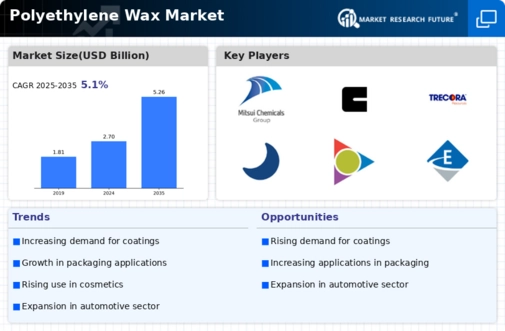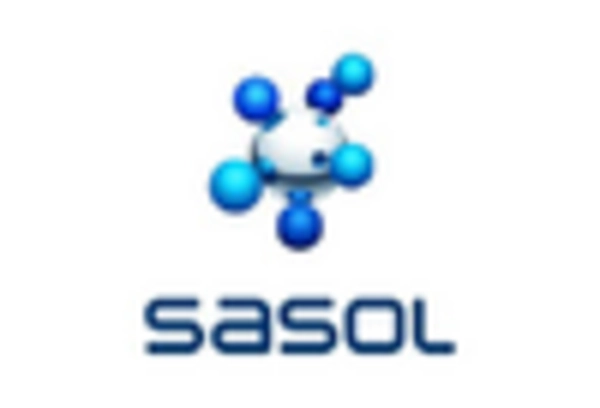Growth in Personal Care Products
The Polyethylene Wax Market is witnessing growth fueled by the rising demand for personal care products. Polyethylene wax serves as a key ingredient in cosmetics, providing texture, stability, and moisture retention. The personal care sector is projected to grow significantly, with estimates suggesting a market value exceeding 500 billion USD by 2025. This growth is attributed to increasing consumer awareness regarding personal grooming and hygiene, alongside a shift towards premium products. As manufacturers seek to enhance product formulations, the incorporation of polyethylene wax is likely to become more prevalent, thereby driving demand within the polyethylene wax market. The versatility of polyethylene wax in various formulations positions it as an essential component in the evolving landscape of personal care.
Increasing Application in Plastics
The Polyethylene Wax Market experiences a notable surge in demand due to its increasing application in the plastics sector. Polyethylene wax is utilized as a processing aid and lubricant in various plastic formulations, enhancing the flow properties and surface finish of the final products. As the plastics industry continues to expand, driven by consumer goods, automotive, and packaging sectors, the need for high-performance additives like polyethylene wax is likely to grow. Recent data indicates that the plastics market is projected to reach a value of over 600 billion USD by 2025, suggesting a robust growth trajectory that could positively impact the polyethylene wax market. This trend indicates a promising future for polyethylene wax as a critical component in enhancing the performance of plastic materials.
Rising Demand in the Rubber Industry
The Polyethylene Wax Market is benefiting from the rising demand in the rubber industry. Polyethylene wax is employed as a processing aid and lubricant in rubber formulations, enhancing the flow and dispersion of fillers. The rubber market is anticipated to grow, with projections indicating a value of over 40 billion USD by 2025, driven by automotive and industrial applications. As manufacturers strive to improve the quality and performance of rubber products, the incorporation of polyethylene wax is likely to become more common. This trend suggests a favorable outlook for the polyethylene wax market, as it aligns with the industry's need for high-performance additives that can enhance product characteristics.
Expansion in the Adhesives and Sealants Sector
The Polyethylene Wax Market is poised for growth due to the expansion of the adhesives and sealants sector. Polyethylene wax is utilized to improve the performance characteristics of adhesives, enhancing their adhesion properties and thermal stability. The adhesives market is projected to reach approximately 70 billion USD by 2025, driven by increasing applications in construction, automotive, and packaging industries. This growth presents a significant opportunity for polyethylene wax, as manufacturers increasingly seek to optimize their adhesive formulations. The integration of polyethylene wax can lead to improved product performance, which is likely to attract more manufacturers to incorporate it into their products, thereby bolstering the polyethylene wax market.
Technological Innovations in Production Processes
The Polyethylene Wax Market is experiencing a transformation due to technological innovations in production processes. Advances in manufacturing techniques, such as the development of more efficient polymerization methods, are enhancing the quality and consistency of polyethylene wax. These innovations not only improve production efficiency but also reduce costs, making polyethylene wax more accessible to various industries. As production capabilities expand, the market is likely to see an increase in supply, which could lead to competitive pricing and broader adoption across sectors such as coatings, plastics, and personal care. This evolution in production technology appears to be a key driver for the polyethylene wax market, potentially reshaping its landscape in the coming years.



 Source: Secondary Research, Primary Research, Market Research Future Database, and Analyst Review
Source: Secondary Research, Primary Research, Market Research Future Database, and Analyst Review













Leave a Comment